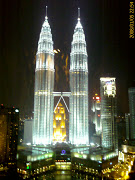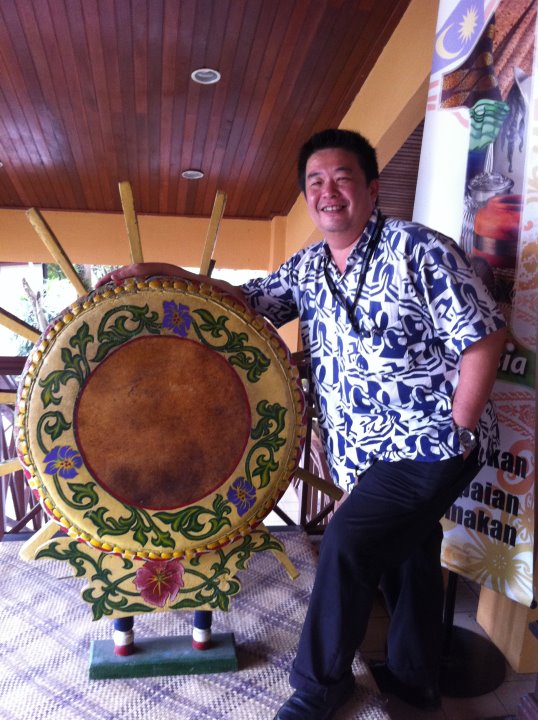
Devotees praying for the souls of the departed at Nilai Memorial Park.
The five horses symbolise earth, water, wind, fire and metal which sustain life.
Dr Ong Seng Huat.
Sources : The Star, Saturday August 30, 2008
Ghosts of the past
By LOUISA LIM
The Hungry Ghosts Festival is one of the most misunderstood Chinese celebrations. It’s also much less spooky and much more remarkable than you think.
If you, like most Malaysians, think that the Hungry Ghosts Festival is all about starving ghouls roaming the earth and not much else, don’t let Dr Ong Seng Huat know — he’ll smack you on the head.
The chief executive director of Xiao En Cultural Foundation — a non-profit, charity-based organisation that promotes academic research and cultural exchange in Asia — Dr Ong doesn’t really believe in ghosts. Or at least, he doesn’t think that the Hungry Ghosts Festival has a whole lot to do with ghosts.
Strange?
“The term ‘hungry ghost’ was coined by the British when they first set foot in the Far East,” Dr Ong says.
“But they misinterpreted the Chinese rituals to be something scary and absurd. Decades may have passed since then, but it’s still being defined this way. That’s colonialism at its best.”
Dr Ong has spent the past few years trying to fix this misconception. He’s even got a book out on the subject. Nevertheless, it’s a long road ahead for this free-thinking maverick, especially when it comes to battling cultural and religious ideas that have held sway for so long.
The truth about ghosts
“The Chinese never had a solid concept of festival. We don’t go out and party the way Westerners do. For us, festivals are very family-oriented. It’s always a time to go home to our families and remember those who have passed on. This tradition dates back centuries, when our ancestors from China used to gather after the harvest season was over,” Dr Ong says.
He believes that the same goes for the Hungry Ghosts Festival, or Zhong Yuan Jie, as the Chinese call it. The rituals, as far as he’s concerned, grew out of society’s need to resolve a social concern that was then plaguing a particular era.
“In China, Zhong Yuan Jie marked a dramatic shift in the seasons,” he adds.
“There was a sharp spike in the number of deaths and fatal illnesses during this period due to the shortage of food and sub-zero temperatures. The villagers believed that a person’s spirit would be restless if he died tragically, and had therefore prayed for these departed souls.”
The lighting of joss sticks evolved from this era because it served two purposes: firstly, to provide some relief from the freezing cold, and secondly, to get rid of the flies and diseases that were spreading.
“The joss sticks were nothing like the ones you have today,” he claims.
“They contained medicinal properties and benefited anyone who caught a whiff of it, since it was made by the village doctors. Meanwhile, we’ve got the capitalists to thank for the modern versions, which contain enough poison to pollute the earth and everything in it.”
This festival, however, wasn’t made official until the Zhou dynasty (1122BC-256BC), when a special treatise called the Record of Rites was compiled by a Confucianist student who thought it was a fundamental doctrine for every human being.
“It tells you to pay respect to those before you and to thank them for the sacrifices they have made. After all, without them, you wouldn’t be here, and the world wouldn’t be where it is now. This is the most basic concept of filial piety, or xiao tao.”
Resurrecting the past
The story, according to Dr Ong, began like this: Confucius was in a class with his students when he asked for the definition of “xiao tao”.
A student raised his hand and answered, “It means providing your parents with shelter and food, and taking care of them if they’re ill.”
Confucius roared with laughter upon hearing the reply.
“You’ve not learned anything from my classes, have you, boy?” he said. “You speak of your parents as if they’re on equal footing with the chickens and pigs from the farm. Filial piety goes beyond obligations. What about respect or deep honour?”
These two main elements, says Dr Ong, would be constantly emphasised throughout Confucius’ lifetime because the concept of filial piety was believed to be the root of all virtues. It is also a fragile one, and easily forgotten in a world like today.
“In other words, the world doesn’t revolve around you,” Dr Ong says.
“Both parent and child are shaped by others, especially their families, and that’s why they should always show their appreciation by respecting the elders and caring for the young.
Confucius believed that doing this could help to cultivate your heart and soul. Just imagine, if everyone were this way, the world would be a far better place.”
The Chinese government was so impressed with this plan that every dynasty since the Zhou period had a scholar specially appointed to interpret the Record of Rites according to their needs and limitations.
Word about this amazing doctrine spread so widely that even the Koreans and Japanese adopted it for the benefit of their own people. The teachings were later perfected by the Buddhists, who believed that a person could only be upgraded spiritually if they were to put others before themselves.
“What annoys me is that all the other societies still practise this, except the Chinese,” Dr Ong reveals.
“I went to a conference the other day, and this Korean chap smugly told me that the Record of Rites is being translated into contemporary context by the Korean government till this very day. We, on the other hand, are forgetting our past.”
Not surprisingly, Dr Ong is a stickler for the past.
The past, he claims, is trying to teach us something. Any beliefs and rituals that we have today were, in fact, created long ago as a form of symbolism and social education.
“Take the recent Enlightenment Ceremony at Nilai Memorial Park,” he says. “The fact that there are families folding and burning paper lotuses all over the place would stump an average man with little or no understanding of history.”
The paper lotuses, as it turns out, is a symbol for spiritual purity because these flowers retain their pristine quality despite growing from the mud. When it’s set alight, these lotuses signify spiritual transformation, or a release from the physical being, a process that is necessary for enlightenment.
“This metaphorical richness applies to everything else,” Dr Ong says, referring to other practices during the Hungry Ghosts Festival.
“I suppose you can call the Chinese an imaginative bunch. Unfortunately, they can drive you insane with their complaints, too. They whine about the amount of superstitions the older generation have, and how some people are silly enough to believe them. But it’s not a matter of believing, but rather, of remembering your roots.
“After all, we Chinese have got 8,000 years of history behind us.”
What does the Hungry Ghosts Festival mean to you?
Michelle Chan, 26, investment analyst
“I’ve always been fascinated with the Hungry Ghosts Festival, compared to the other Chinese celebrations because it relates to spirits and the supernatural.
“Even though I’m a level-headed person and I come from a Malay-educated background, I try to be a little more careful during this month. I won’t step on ashes from joss sticks or hell money, for instance.”
Ong Chee Khim, 22, student
“My mum tells me to avoid dark, deserted places or going out after midnight, because it’s the time of year when the gates of hell are open, and more ghosts are wandering about than usual. I don’t know if what she’s saying is true, but I don’t wish to find out.”
Elaine Tan, 32, freelance writer
“It’s a non-event to me. I don’t even notice it until I start hearing free entertainment blaring late into the night, courtesy of the Poh Toh Society down the road from where I live.
“Unlike many of my peers, I can’t recall my parents ever telling us anything about what we can or cannot do during hungry ghosts month because they aren’t really superstitious to begin with.”
Karim Rashid, 45, sales manager
“My wife is a Chinese from Penang so I know a thing or two about this festival. They believe that the spirits must be appeased in order to get good fortune and better luck in their lives, so they burn offerings and put on stage performances.
“It affected us because my wife was restricted from doing all kinds of things back when we were dating, including going swimming!”
Daniel Martin, 36, self-employed
“I’m used to travelling all around Asia for work and I’ve seen the way this festival is celebrated on a wide scale, particularly in Malaysia, Singapore, China and even Vietnam.
“The people are also always happy to tell stories of their own ghostly encounters, like seeing shadowy figures huddled over the offerings and what-not.
“What really creeps me out, however, is how the monks will set up massive altars on the streets and sing eerie songs that only these spirits can understand.”
The Hungry Ghosts Festival happens during the 7th month in the Chinese Lunar Calender and ends today.






























